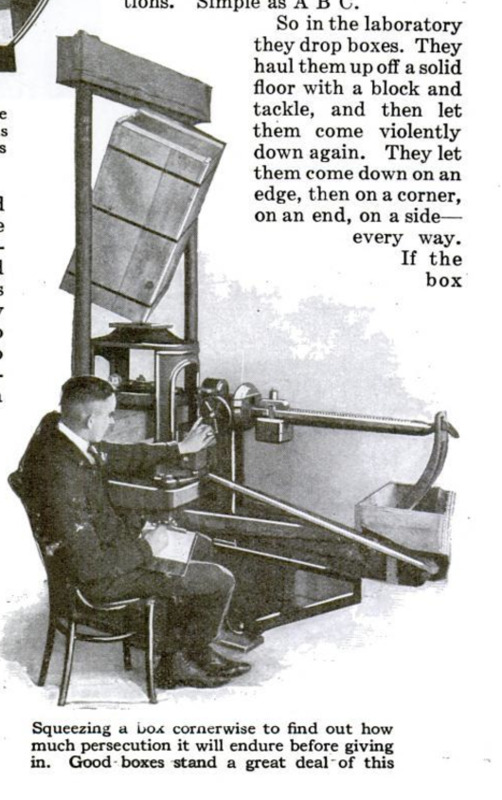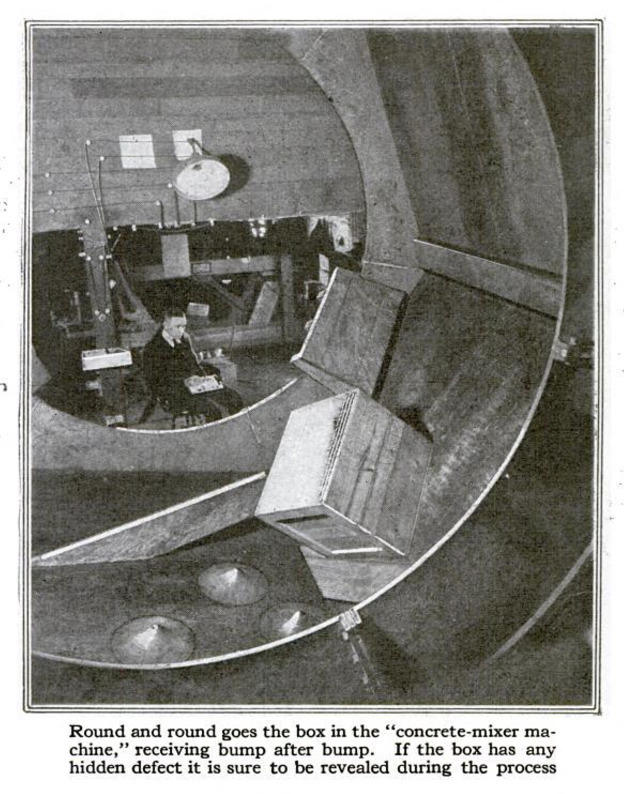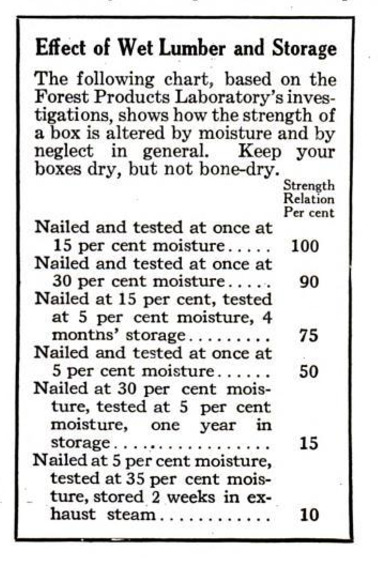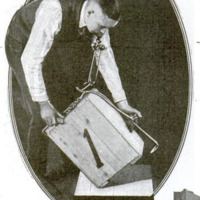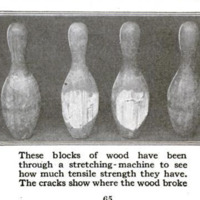-
Titolo
-
The experiments made to improve the shipment of war supplies and the importance of their results for commerce in peacetime
-
Article Title and/or Image Caption
-
Can You Make a Crate that Won't Break? Some results of the Forest Products Laboratory's experiments in the testing of boxes, barrels and crates
-
extracted text
-
SHIPPERS have, within recent
years, rather been forced to the
conclusion that there is a science
and art in the building of shipping con-
tainers. Before the war this conclu-
sion was thrust upon them by the
mishaps that befell them in attempt-
ing to reach South American and other
foreign trade.
But during the war the idea crystall-
ized. It culminated in special activity
on the part of the Forest Products
Laboratory at Madison, Wisconsin—
a branch establishment of the United
States Department of Agriculture.
Here a school was brought into being
for the training of men having to do
with the packing and crating of
quantities of material sent overseas.
The tests made here, primarily
instituted to promote war efficiency,
have provided a fund of information
that will be invaluable to manufac-
turers and shippers in peace time.
The shipping departments of the
larger manufacturers have already
‘made tests and experiments of their
own. In fact, every package sent
out is an experiment. But the sub-
jeet is still dark and uncertain in a
great many of its aspects. So we
pass along the results of the Forest
Products Laboratory's experience
because of their special value in
contributing to the general fund of
knowledge on the subject.
What methods are followed in
this packing-box testing laboratory?
We may preface an explanation by
quoting D. L. Quinn, in charge of the
Madison Laboratory's work:
“A properly designed packing-box is
one which has enough strength in each
part for the purpose for which it is in-
tended. More than this, it should
‘have no more strength in any part than
is necessary to balance the average
strength in every other part. The,
data necessary for designing such a box |
cannot be obtained from observation of
boxes in actual commercial service, be-
cause the observer sees the box only
after it has completely failed. He docs
not seo the beginning of tho failures;
and he does not see, and consequently
cannot measure, the hazard which
completes them.
“A failure frequently bears evidence
in itself of the cause of the damage.
There is, however, no way of determin.
ing from a study of the failure the |
amount of force exerted by the damag-
ing cause. In cases where several
causes have been active, it is im
‘possible to identify each of them.” |
He concludes, therefore, that the |
immediate task of a testing laboratory
isto go at one thing at a time. That
is, the tests applied to containers
should be of such a nature that defects |
will be shown up singly, and
under such conditions that the
stress applied, and also the re-
sults, may be carefully checked
up and kept track of. By thus
measuring defects individually
and “pooling” the results, so to
speak, the tester will be able to
gain a comprehensive knowl-
edge of the all-around strength
of the box or crate, and its
probable capabilities when
in actual service.
Initiating Tests
The “compression along
an edge” is one of the tests
applied. This consists in
standing a box upon one
edge and applying a steady
and constantly increasing
pressure to the diagonally
opposite edge. The longer
the box holds out against
such a squeeze, the better
box it is. Another box of
the same kind will be stood up on one
corner, and then pressure applied to
the opposite uppermost corner. The
longer the box holds out against this
"test, the better box it is. The il-
lustration at the bottom of this
page shows details of the process.
Another test applied to boxes in a
laboratory is to drop them. Simple,
isn't it? Even a youngster applies
that principle. If Amy Brown has
doll with a china head, and she de-
liberately drops the doll on a cement
sidewalk, and the head doesn’t
break—why, naturally, the doll is a
better one than Dorothy Smith's,
which does break under such condi-
tions, Simple as A B C.
So in the laboratory
they drop boxes. They
haul them up off a solid
floor with a block and
tackle, and then let
them come violently
down again. They let
them come down on an
edge, then on a corner,
onan end, on a side—
every way.
If the
box
stands up under all that, it is a good
box and can be depended upon to
stand up under actual service; because
such man-handling as this is what the
box actually gets from the freight
rustlers and dock employees. The
testors reason that it is better to find
out in a laboratory whether a given
kind of box is no good for
its purpose than to find
out on the road, and per-
haps lose valuable goods in
the process. That this is
sound reasoning, is evident.
The Revolving Drum
A particularly choice
‘number in the repertoire of
the testing men is to run a
box through the revolving
drum apparatus. This looks
a good deal like a concrete-
mixer, only its drum is
larger. A box is put inside
the drum, then the drum +
proceeds to go round and
round in regular concrete-
mixer fashion. Meanwhile
the box is bumping around
among all kinds of pillars
and posts inside. When it
‘comes through this test—if
it does come through —it is
initiated indeed.
The drum revolves so
slowly that, as the box
drops from one projection
to the next, the beginning
of breaks and cracks can
be noted. The weak
points in the construe-
tion of the box will, of
course, readily make them-
selves apparent, and in the next box.
made along this line, the construction
can be altered in such a way as to avoid
defects of the kind that the test
brought out. By continually building
and testing in this way, boxes are
ultimately developed that are equally
strong in all features. Like the “one- |
hoss shay,” they will go to pieces all at
once, if they go to pieces at all. Their
failure will not be because of single
defects, such as nails pulled through
soft wood, or because ends of boards
split or broke off, or because the wrong
Tumber was used for that particular box |
inthe first place. The box constructor
will know what he is doing.
The laboratory has found that the
length of a nail, rather than its gage,
seems to be the principal factor in its
holding power. Since nails split wood,
it has been found that it is desirable
that as small gage nail be used as can
be driven by a nailing-machine. Mr.
Quinn finds that -standard cement
coated box nails seem to be most desir-
able from the standpoint of both
efficiency and economy.
“Nails,” says Mr. Quinn, “should be
driven flush with the wood. They
should never be over-driven. Over-
driving causes the heads to break the
fiber of the wood under them, often
to such an extent that no holding
power is loft in the wood. Tho first
strain on the box then causes the wood
to pull away from the nails. The evil
effect of over-driving nails naturally
Increases as the material In
the boards is made thinner.
But in any box over-driving
is bad practice, and should
be guarded against.
“The size of the nail to
“be used depends upon the
species and the thickness of
the lumber in which the
points of the nails are held.
With the woods white elm,
red gum, sycamore, pump-
kin ash, black ash, black
gum, tupelo, and soft or
silver maple, as well as hard
maple, beech, oak, hack-
berry, birch, rock efm, and
white ash, the penny of the
nail should be the same as
the thickness of the lumber
expressed in eighths of an
inch. The following woods
take the next penny
larger: white pine, Norway
pine, aspen, spruce, South-
ern ‘and Western’ yellow
pine, cottonwood, yellow
poplar, balsam fir, ‘chest-
nut, sugar pine, basswood,
cypress, willow, noble fir,
magnolia, buckeye, white
fir, cedar, redwood, butter
nut, cucumber, alpine fir,
lodgepole pine, hemlock,
Virginia and Carolina pine,
Douglas fir, and larch.
_“Sixpenny nails and smaller should
be spaced not more than two inches
apart when driven in the side grain of
the end, and not more than one and
three fourths inches apart when driven
inthe end grain. The spacing of nails
in end construction should be in-
creased from the above, one fourth
inch for each penny over six.”
More Facts About Nails
One hardly realizes the force it takes
to pull a nail out of a wooden board.
In experimenting with the holding
‘power of cement-coated, plain, and
barbed sevenpenny nails, driven
one inch into dry wood, Mr. Quinn
obtained the following facts:
Using a cement-coated nail, it
takes about a 225-pound pull to get
a nail out of one inch of longleaf
yellow pine, 133 pounds out of bass-
wood, and 430 pounds out of beech.
Plain nails took 140 pounds with
longleaf pine, 82 pounds with
basswood, and 400 pounds with
beech. Barbed nails required only
110 pounds with longleaf pine,
70 pounds with basswood, and 335
pounds with beech.
-
Autore secondario
-
Lloyd E. Darling (writer)
-
Lingua
-
eng
-
Data di rilascio
-
1919-10
-
pagine
-
64-65
-
Diritti
-
Public domain (Google digitized)
-
Archived by
-
Davide Donà
-
Alberto Bordignon (Supervisor)


